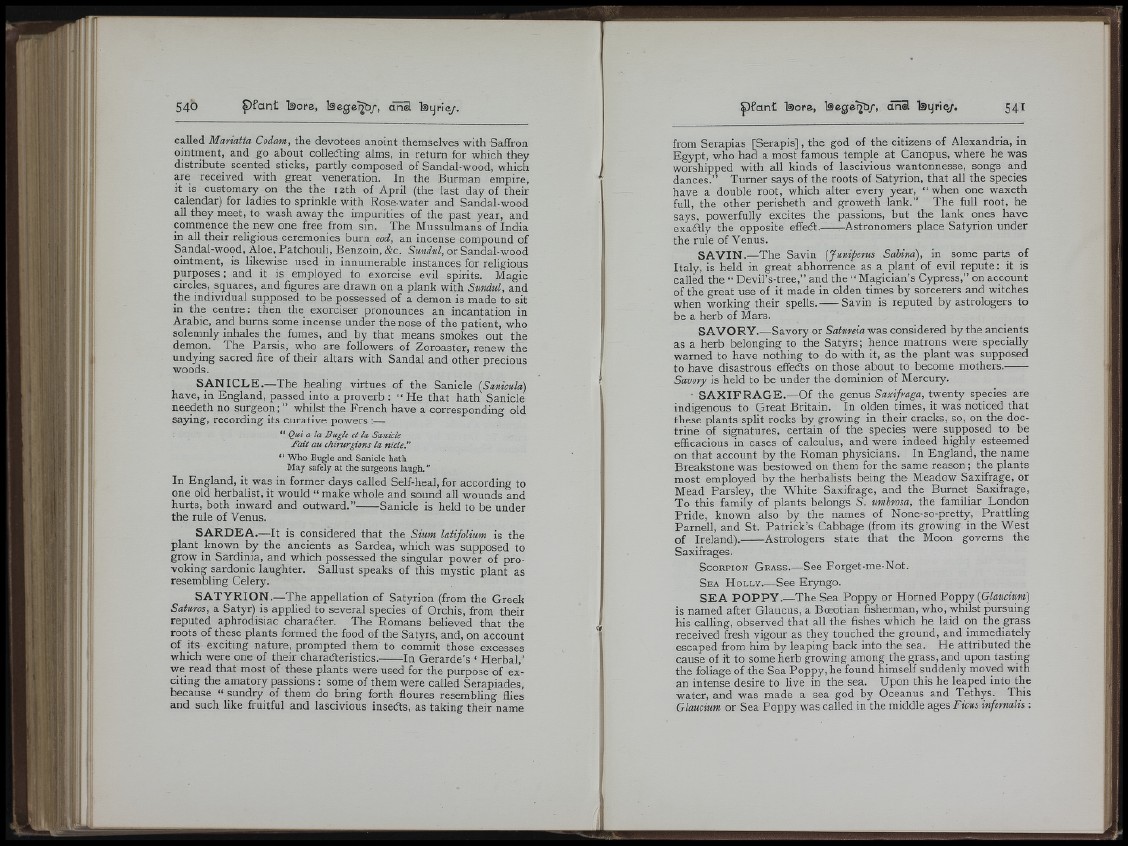
w w
i \
Pi
called Mariatta Codam, the devotees anoint themselves with Saffron
ointment, and go about colledting alms, in return for which they
distribute scented sticks, partly composed of Sandal-wood, which
are received with great veneration. In the Burman empire,
it is customary on the the 12th of April (the last day of their
calendar) for ladies to sprinkle with Rose-water and Sandal-wood
all they meet, to wash away the impurities of the past year, and
commence the new one free from sin. The Mussulmans of India
in all their religious ceremonies burn ood, an incense compound of
Sandal-wood, Aloe, Patchouli, Benzoin, &c. Sundul, or Sandal-wood
ointment, is likewise used in innumerable instances for religious
purposes; and it is employed to exorcise evil spirits. Magic
circles, squares, and figures are drawn on a plank with Sundul, and
the individual supposed to be possessed of a demon is made to sit
in the centre: then the exerciser pronounces an incantation in
Arabic, and burns some incense under the nose of the patient, who
solemnly inhales the fumes, and by that means smokes out the
demon. The Parsis, who are followers of Zoroaster, renew the
undying sacred fire of their altars with Sandal and other precious
woods.
S A N IC L E .—The healing virtues of the Sanicle {Sanicula)
have, in England, passed into a proverb : “ He that hath Sanicle
needeth no surgeon;” whilst the French have a corresponding old
saying, recording its curative powers :—
" Qui a la Bugle et la Sanicle
Fait au chirurgions la n icle !
“ Who Bugle and Sanicle hath
May safely at the surgeons laugh.”
In England, it was in former days called Self-heal, for according to
one old herbalist, it would “ make whole and sound all wounds and
hurts, both inward and outward.” Sanicle is held to be under
the rule of Venus.
S A R D E A .—It is considered that the Sium latifolium is the
plant known by the ancients as Sardea, which was supposed to
grow in Sardinia, and which possessed the singular power of provoking
sardonic laughter. Sallust speaks of this mystic plant as
resembling Celery.
S A T Y R IO N .—The appellation of Satyrion (from the Greek
Saturas, a Satyr) is applied to several species of Orchis, from their
reputed aphrodisiac charadter. The Romans believed that the
roots of these plants formed the food of the Satyrs, and, on account
of its exciting nature, prompted them to commit those excesses
which were one of their charadteristics. In Gerarde’s ‘ Herbal,’
we read that most of these plants were used for the purpose of exciting
the amatory passions : some of them were called Serapiades,
because “ sundry of them do bring forth fioures resembling flies
and such like fruitful and lascivious insedls, as taking their name
from Serapias [Serapis], the god of the citizens of Alexandria, in
Egypt, who had a most famous temple at Canopus, where he was
worshipped with all kinds of lascivious wantonnesse, songs and
dances.” Turner says of the roots of Satyrion, that all the species
have a double root, which alter every year, “ when one waxeth
full, the other perisheth and groweth lank.” The full root, he
says, powerfully excites the passions, but the lank ones have
exadlly the opposite effedl. -Astronomers place Satyrion under
the rule of Venus.
S A V IN .—The Savin {Juniperus Sabina), in some parts of
Italy, is held in great abhorrence as a plant of evil repute: it is
called the “ Devil’s-tree,” and the “ Magician’s Cypress,” on account
of the great use of it made in olden times by sorcerers and witches
when working their spells. Savin is reputed by astrologers to
be a herb of Mars.
S A V O R Y .—Savory or Satureiawas considered by the ancients
as a herb belonging to the S a ty rs; hence matrons were specially
warned to have nothing to do with it, as the plant was supposed
to have disastrous effedts on those about to become mothers.------
Savory is held to be under the dominion of Mercury.
■ S A X I F R A G E .—Of the genus Saxifraga, twenty species are
indigenous to Great Britain, In olden times, it was noticed that
these plants split rocks by growing in their cracks, so, on the doctrine
of signatures, certain of the species were supposed to be
efficacious in cases of calculus, and were indeed highly esteemed
on that account by the Roman physicians. In England, the name
Breakstone was bestowed on them for the same reason; the plants
most employed by the herbalists being the Meadow Saxifrage, or
Mead Parsley, the White Saxifrage, and the Burnet Saxifrage,
To this family of plants belongs S. umbrosa, the familiar London
Pride, known also by the names of None-so-pretty, Prattling
Parnell, and St. Patrick’s Cabbage (from its growing in the West
of Ireland). Astrologers state that the Moon governs the
Saxifrages.
S c o r p io n G r a s s .— See Forget-me-Not.
S e a H o l l y .— See Eryngo.
S E A P O P P Y .—The Sea Poppy or Horned Vo^y>y [Claucium)
is named after Glaucus, a Boeotian fisherman, who, whilst pursuing
his calling, observed that all the fishes which he laid on the grass
received fresh vigour as they touched the ground, and immediately
escaped from him by leaping back into the sea. He attributed the
cause of it to some herb growing among the grass, and upon tasting
the foliage of the Sea Poppy, he found himself suddenly moved with
an intense desire to live in the sea. Upon this he leaped into the
water, and was made a sea god by Oceanus and Tethys. This
Claucium or Sea Poppy was called in the middle ages Ficus infernalis :